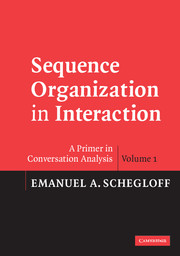Book contents
- Frontmatter
- Contents
- Preface
- Acknowledgments
- 1 Introduction to sequence organization
- 2 The adjacency pair as the unit for sequence construction
- 3 Minimal, two-turn adjacency pair sequences
- 4 Pre-expansion
- 5 The organization of preference/dispreference
- 6 Insert expansion
- 7 Post-expansion
- 8 Topic-proffering sequences: a distinctive adjacency pair sequence structure
- 9 Sequence-closing sequences
- 10 Sequences of sequences
- 11 Retro-sequences
- 12 Some variations in sequence organization
- 13 Sequence as practice
- 14 Summary and Applications
- Appendix 1 Conversation-analytic transcript symbols
- Appendix 2 Transcript of a telephone call
- References
- Index
5 - The organization of preference/dispreference
Published online by Cambridge University Press: 05 September 2012
- Frontmatter
- Contents
- Preface
- Acknowledgments
- 1 Introduction to sequence organization
- 2 The adjacency pair as the unit for sequence construction
- 3 Minimal, two-turn adjacency pair sequences
- 4 Pre-expansion
- 5 The organization of preference/dispreference
- 6 Insert expansion
- 7 Post-expansion
- 8 Topic-proffering sequences: a distinctive adjacency pair sequence structure
- 9 Sequence-closing sequences
- 10 Sequences of sequences
- 11 Retro-sequences
- 12 Some variations in sequence organization
- 13 Sequence as practice
- 14 Summary and Applications
- Appendix 1 Conversation-analytic transcript symbols
- Appendix 2 Transcript of a telephone call
- References
- Index
Summary
We ended our initial discussion of pre-sequences with the observation that they seem largely designed to avoid various kinds of trouble in the sequence which a prospective first pair part would start. For one, the generic pre-sequence – the summons–answer sequence – is designed to avoid trouble due to non-uptake of the whole of the utterance; that is, trouble (on the addressee's part) in registering that one is being addressed, and with what. The summons–answer sequence is built and deployed to establish the availability and the alignment of the addressee as recipient for the talk about to be done – if the addressee is available for interaction or for its next increment by this speaker (and to secure that availability and recipiency, if it is problematic). Again, one main use of “pre-pre's” is to establish in advance that the addressee knows the things, persons, etc. that an imminent first pair part will make reference to, thereby contributing to the avoidance of its “failure” because of trouble in its “infrastructure” of understandability.
But the most common potential trouble of a projected adjacency pair-based sequence which pre-sequences seem built to anticipate and to circumvent is rejection or disagreement, or, to use the more general term, “dispreferred responses.” It may be useful at the outset to try to sort out these terms and what we will – and will not – mean by them.
- Type
- Chapter
- Information
- Sequence Organization in InteractionA Primer in Conversation Analysis, pp. 58 - 96Publisher: Cambridge University PressPrint publication year: 2007
- 2
- Cited by



